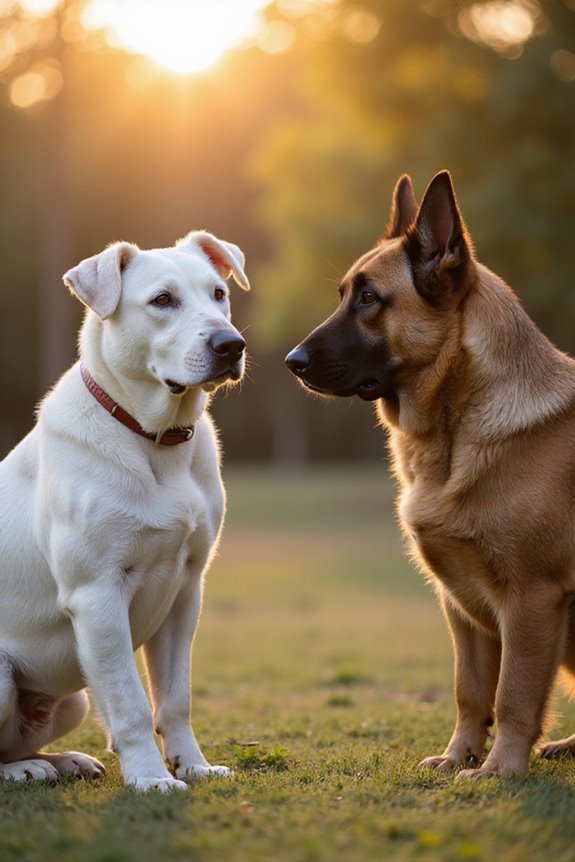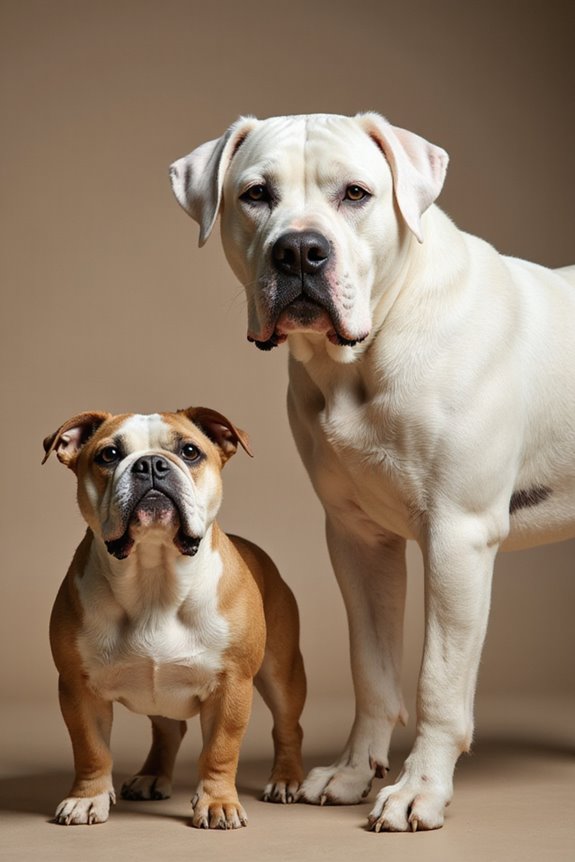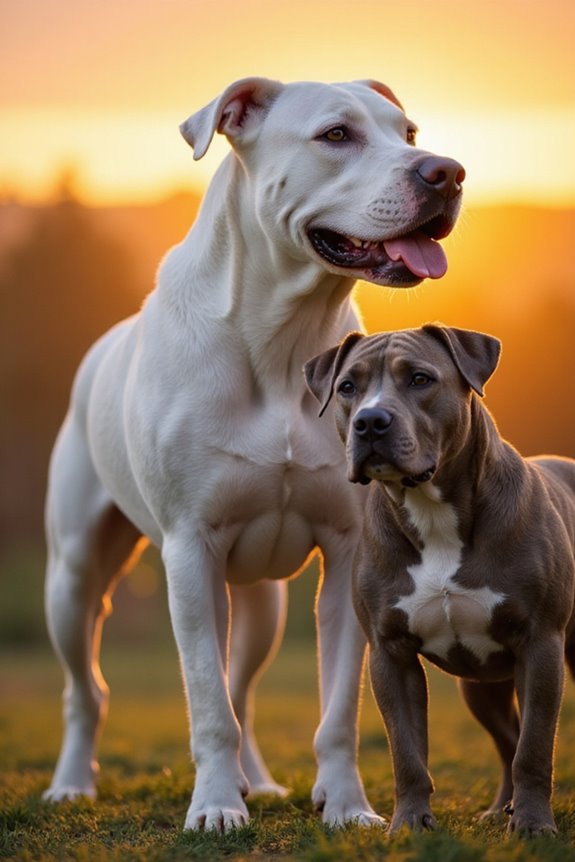In the ultimate guard dog battle between the Dogo Argentino and German Shepherd, several factors must be considered. The Dogo Argentino is larger, heavier, and possesses a muscular build, while the German Shepherd excels in obedience and adaptability. Both breeds have natural protective instincts; however, the Dogo Argentino tends to be more aggressive, while the German Shepherd is more sociable. Understanding these distinctions is essential for making an informed decision about which breed suits your needs best; let’s explore their differences in depth.
Key Takeaways
- The Dogo Argentino is physically stronger and more aggressive, making it a formidable protector in high-threat scenarios.
- German Shepherds are proficient at analyzing threats, using intimidation effectively while being loyal and obedient family companions.
- Both breeds require early socialization and training to manage their protective instincts and ensure they behave appropriately.
- Dogo Argentinos demand more physical activity, while German Shepherds adapt well to various living conditions and lifestyles.
- For families, German Shepherds are often better suited due to their affectionate nature and compatibility with children.
Physical Attributes and Size Comparison
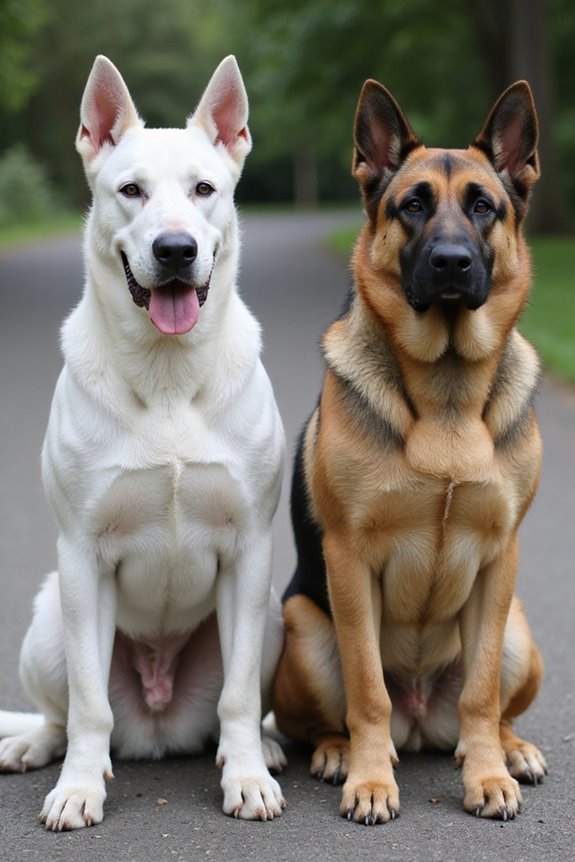
When comparing the physical attributes and size of the Dogo Argentino and the German Shepherd, it is essential to take into account several key factors: height, weight, body build, and coat characteristics. The Dogo Argentino averages slightly taller, with males around 25.5 inches and females at 24 inches. In contrast, male German Shepherds are typically 25 inches tall and females 23 inches.
In terms of weight, male Dogo Argentinos are heftier, averaging 93.5 pounds, thanks to their muscle density, compared to around 77 pounds for male German Shepherds. The Dogo has a short, smooth coat, requiring minimal coat maintenance, whereas the German Shepherd’s dense double coat needs regular grooming to manage shedding.
Temperament and Personality Traits
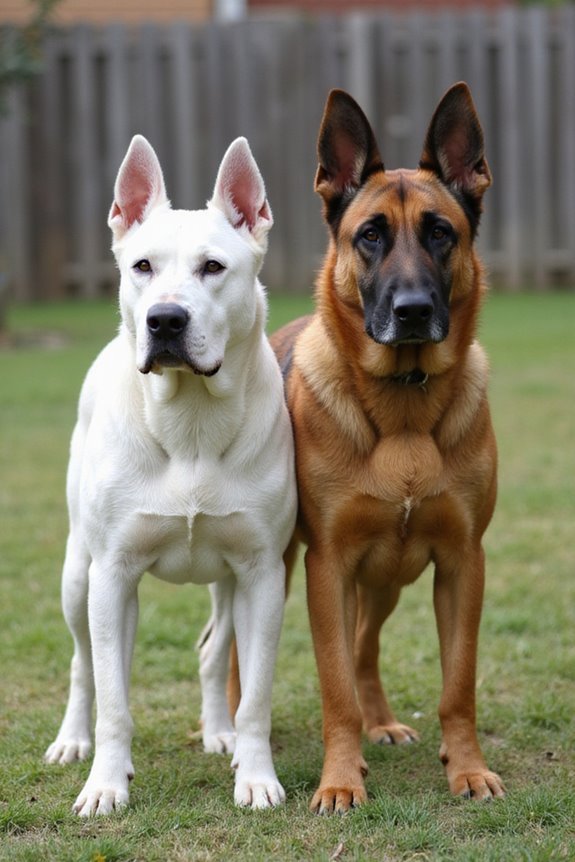
Understanding the temperament and personality traits of both the Dogo Argentino and German Shepherd is essential for potential owners.
- Dogo Argentino: Known for its brave and vigilant demeanor, this breed displays emotional stability within family settings. While protective, it is also easygoing. However, it’s less sociable and affectionate compared to the German Shepherd.
- German Shepherd: This breed balances playful energy with loyalty and obedience. Its high sensitivity requires routine to maintain temperament consistency, as disruptions can lead to anxiety. German Shepherds are affectionate and more adaptable in social settings, often forming stronger bonds with family members.
Ultimately, choosing between these breeds hinges on understanding their distinct temperament traits and emotional responses, ensuring a fulfilling companionship.
Guarding and Protective Instincts
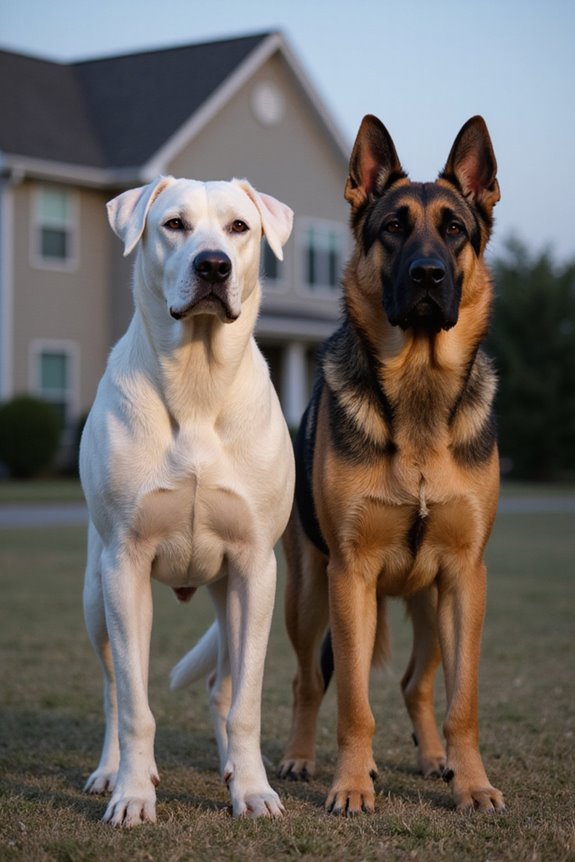
Both the Dogo Argentino and German Shepherd have inherent guarding and protective instincts that are vital for potential owners to understand. These breeds possess natural guarding techniques, deeply ingrained through selective breeding. German Shepherds are notable for their ability to assess threats, making them exemplary watchdogs and guard dogs. In contrast, Dogo Argentinos exhibit aggressive protective behaviors, relying on their physical strength to confront threats head-on.
- Territorial Awareness: Both breeds alert families to unfamiliar presences.
- Response to Threats: German Shepherds use intimidation, while Dogo Argentinos often act with direct aggression.
Training is essential for both breeds to manage guarding instincts effectively, as improper handling can exacerbate overzealous protective behaviors. Consequently, consistent socialization and experienced management of these instincts are recommended.
Bite Strength and Risk Assessment
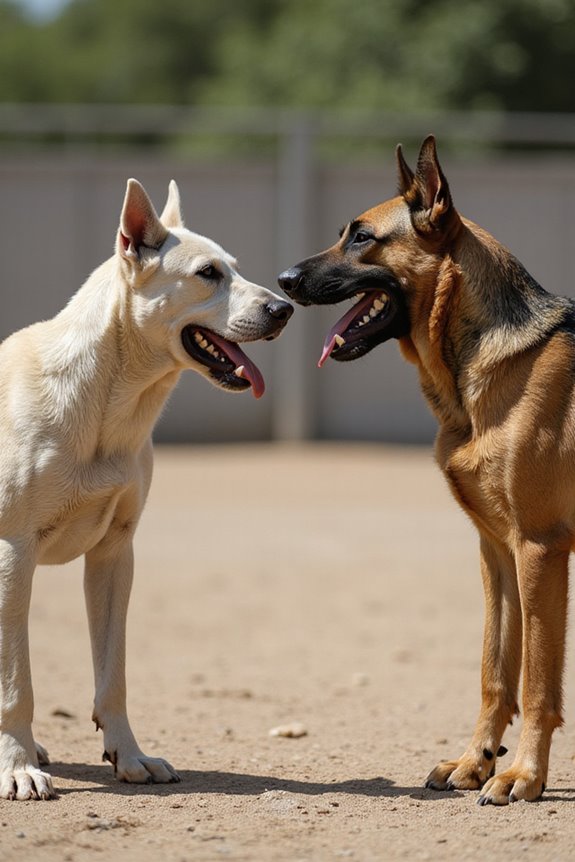
While one might readily acknowledge the importance of bite strength in evaluating canine risk, it’s essential to explore deeper into how this physical characteristic interacts with a dog’s behavior and training. The Dogo Argentino boasts an impressive bite force averaging around 500 PSI, considerably higher than the German Shepherd‘s 238 PSI. This notable difference translates into a higher injury potential, particularly in uncontrolled scenarios, where the Dogo Argentino may inflict deep punctures or fractures. Conversely, German Shepherds have a balanced approach, demonstrating effective bite control in protection roles. Understanding that bite strength alone doesn’t determine risk is critical; it’s the combination of training and behavior that truly influences the severity and potential of any canine attack.
Trainability and Versatility of Both Breeds
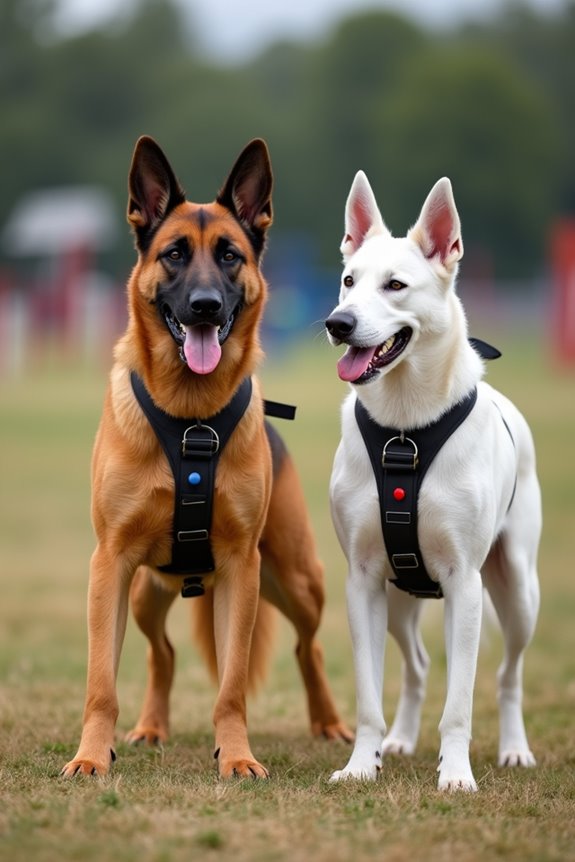
When it comes to evaluating the trainability and versatility of the Dogo Argentino and the German Shepherd, several factors must be taken into account, including breed characteristics, historical roles, and training methodologies.
German Shepherds
- Trainability: These dogs rank among the most intelligent, excelling in obedience and complex commands.
- Versatility: Adaptable across various roles, they thrive in police work, service duties, and family settings.
Dogo Argentinos
- Trainability: Known for their strong-willed temperament, they need experienced handlers and consistent training techniques but can be challenged by their independent nature.
- Versatility: Primarily used for protection and big-game hunting, they’re less adaptable to varied roles, requiring structured training to mitigate behavioral challenges.
Both breeds benefit from early socialization, vital for their success as effective guard dogs.
Living Conditions and Suitability
Understanding living conditions and suitability for the Dogo Argentino and the German Shepherd is essential for potential owners.
- Living Space: The German Shepherd adapts well to various environments, finding comfort in apartments or smaller yards. In contrast, Dogo Argentinos need larger spaces due to their size and energy.
- Climate Preferences: German Shepherds thrive in climates between 40-85 °F, while Dogo Argentinos prefer milder conditions, around 45-80 °F.
Both breeds require adequate exercise; however, Dogo Argentinos need more robust physical activity. Insufficient space can lead to destructive behaviors in the Dogo, whereas the German Shepherd may manage better indoors with daily walks. Ultimately, understanding these nuances will help guarantee a harmonious living environment for both dogs and owners.
Child Friendliness and Family Compatibility
Evaluating the child friendliness and family compatibility of the Dogo Argentino and the German Shepherd reveals important considerations for potential dog owners.
- Child Interactions:
- Dogo Argentinos can be loving but need careful supervision due to their strong prey drive.
- German Shepherds form strong bonds with children and tend to engage well in play.
- Family Dynamics:
- Dogo Argentinos thrive in active homes but may struggle in multi-pet households.
- German Shepherds adapt to various living situations and generally cohabitate better with other pets.
Both breeds require early socialization and consistent training for safe interactions with children. Opting for either breed involves understanding their unique needs and temperament to foster a harmonious family environment.
Socialization and Interaction With Strangers
Socialization directly influences how dogs interact with strangers, shaping their behavior and responses in a variety of situations. While both the Dogo Argentino and German Shepherd require early social exposure, their reactions to strangers notably differ:
- Stranger Tolerance: German Shepherds typically demonstrate a balanced approach, showcasing patience and caution, making them more tolerant; Dogo Argentinos, however, often exhibit defensive instincts and are less accepting of unfamiliar people.
- Social Exposure: Early and consistent socialization can enhance a German Shepherd’s friendliness, whereas without diligent training, the Dogo Argentino may struggle with aggression towards strangers.
In essence, the socialization process is essential in managing these breeds’ interactions with unfamiliar individuals, influencing their adaptability and comfort in various environments.
Summary of Key Differences and Similarities
When comparing the Dogo Argentino and German Shepherd, key differences and similarities emerge that can guide potential owners in choosing the right breed for their lifestyle.
Key Differences:
- Size: Dogos are taller (24-30 inches) and heavier (75-110 pounds) than German Shepherds (22-26 inches, 75-95 pounds).
- Breeding Practices: The Dogo Argentino was bred for big-game hunting, while German Shepherds were developed for herding.
Similarities:
- Both breeds are highly protective and excel as guard dogs.
- They require consistent training and early socialization.
Understanding their historical origins enhances our appreciation of their unique traits. Ultimately, choosing between these breeds depends on individual lifestyle needs, whether it’s energy levels, physical space, or the temperament suited for family dynamics.
Frequently Asked Questions
What Are the Grooming Needs for Dogo Argentino and German Shepherd?
When considering grooming needs, I find Dogo Argentinos have a short coat requiring less frequent brushing, while German Shepherds need more attention due to their double coat. It’s all about commitment and care, right?
How Do These Breeds Handle Extreme Weather Conditions?
Did you know that German Shepherds thrive in cold weather, thanks to their double coat? When it comes to weather adaptability, they show impressive breed resilience, unlike Dogo Argentinos, who need more careful monitoring in extreme conditions.
What Is the Lifespan of Dogo Argentino and German Shepherd?
The Dogo Argentino lifespan typically ranges from 9 to 15 years, while a German Shepherd’s lifespan averages between 9 and 13 years. It’s fascinating how genetics and care influence their longevity, isn’t it?
Do Dogo Argentinos and German Shepherds Have Any Common Health Issues?
Yes, both Dogo Argentinos and German Shepherds face shared health challenges, like hip dysplasia and allergies. Their genetic disorders often stem from breed predispositions, making it essential to choose responsible breeders for healthier pups.
How Much Exercise Do Dogo Argentino and German Shepherd Require Daily?
Like a well-oiled machine, my exercise routines for both breeds are essential. Dogo Argentinos need 30 to 90 minutes of vigorous activity, while German Shepherds thrive with 60 to 90 minutes, balancing physical and mental stimulation.

